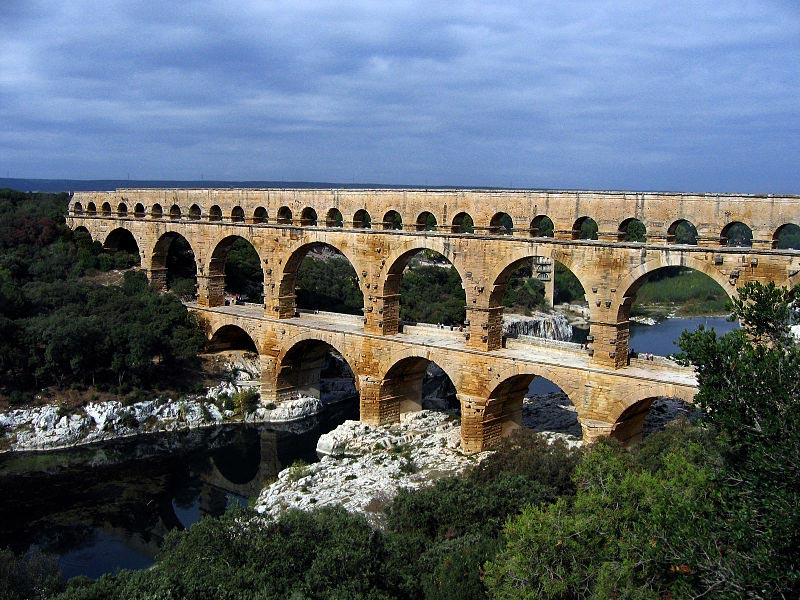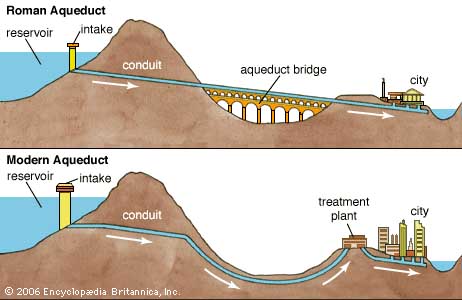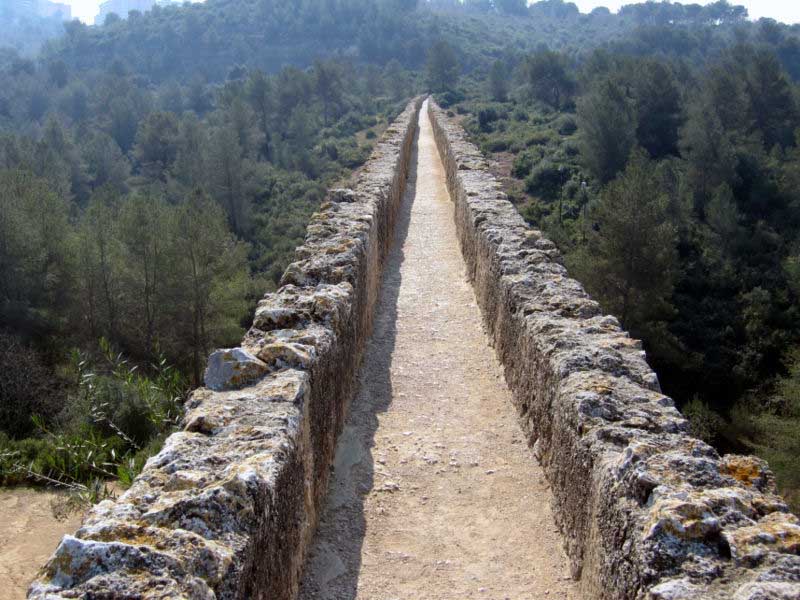

An aqueduct is a water supply or navigable channel constructed to convey water. In modern engineering, the term is used for any system of pipes, ditches, canals, tunnels, and other structures used for this purpose. In a more restricted use, aqueduct (occasionally water bridge) applies to any bridge or viaduct that transports water - instead of a path, road or railway - across a gap. Large navigable aqueducts are used as transport links for boats or ships. Aqueducts must span a crossing at the same level as the watercourses on each end. The word is derived from the Latin aqua ("water") and ducere ("to lead").

The Romans constructed aqueducts to bring a constant flow of water from distant sources into cities and towns, supplying public baths, latrines, fountains and private households. Waste water was removed by the sewage systems and released into nearby bodies of water, keeping the towns clean and free from noxious waste. Some aqueducts also served water for mining, processing, manufacturing, and agriculture.
Aqueducts moved water through gravity alone, along a slight downward gradient within conduits of stone, brick or concrete. Most were buried beneath the ground, and followed its contours; obstructing peaks were circumvented or less often, tunneled through. Where valleys or lowlands intervened, the conduit was carried on bridgework, or its contents fed into high-pressure lead, ceramic or stone pipes and siphoned across. Most aqueduct systems included sedimentation tanks, sluices and distribution tanks to regulate the supply at need.
Rome's first aqueduct supplied a water-fountain sited at the city's cattle-market. By the 3rd century AD, the city had eleven aqueducts, to sustain a population of over 1,000,000 in a water-extravagant economy; most of the water supplied the city's many public baths. Cities and municipalities throughout the Roman Empire emulated this model, and funded aqueducts as objects of public interest and civic pride, "an expensive yet necessary luxury to which all could, and did, aspire."
Most Roman aqueducts proved reliable, and durable; some were maintained into the early modern era, and a few are still partly in use. Methods of aqueduct surveying and construction are given by Vitruvius in his work De Architectura (1st century BC). The general Frontinus gives more detail, in his official report on the problems, uses and abuses of Imperial Rome's public water supply. Notable examples of aqueduct architecture include the supporting piers of the Aqueduct of Segovia, and the aqueduct-fed cisterns of Constantinople.
Before their development of aqueduct technology, Romans, like most of their contemporaries in the ancient world, relied on local water sources such as springs and streams, supplemented by groundwater from privately or publicly owned wells, and by seasonal rain-water drained from rooftops into storage jars and cisterns. The reliance of ancient communities of such water resources restricted their potential growth. Rome's aqueducts were not strictly Roman inventions Ð their engineers would have been familiar with the ancient, tried and tested water-management technologies of Etruscan neighbors and Greek allies Ð but they proved conspicuously successful. By the early Imperial era, the city's aqueducts supported a population of over a million, and an extravagant water supply for public amenities such as baths, fountains and latrines had become a fundamental requirement for a civilized, Roman life.
Rome had several springs within its perimeter walls but its groundwater was notoriously unpalatable, and water from the Tiber was unsafe to drink. The city's demand for water had probably long exceeded its local supplies when the Aqua Appia, Rome's first aqueduct (312 BC) was commissioned by the censor Appius Claudius Caecus as one of two publicly funded, major projects; the other was a strategic road between Rome and Capua, the first leg of the so-called Appian Way.
Both projects had probably high strategic value, as Rome's third Samnite War had been under way for some thirty years. The road allowed rapid troop movements; and by design or fortunate coincidence, most of the Aqua Appia ran within a buried conduit, relatively secure from attack. It was fed by a spring 16.4 km from Rome and dropped 10 meters over its length to discharge approximately 75,500 cubic meters of water per diem into a fountain at Rome's cattle market, the Forum Boarium, one of the city's lowest lying public spaces. A second aqueduct, the Old Anio, was commissioned some forty years later, funded by booty seized from Pyrrhus of Epirus. Its flow was more than twice that of the Aqua Appia, and it entered the city on raised arches, supplying water to higher elevations of the city.
By 145 BC, the city had again outgrown its combined supplies; an official commission found the aqueduct conduits decayed, and depleted by leakage and illegal tapping. The praetor Quintus Marcius Rex restored them, and introduced a third, "more wholesome" supply, the Aqua Marcia, Rome's longest aqueduct and high enough to supply the Capitoline Hill. The works cost 180,000,000 sesterces, and took two years to complete.
As demand grew still further, more aqueducts were built; the Aqua Tepula in 127 BC and the Aqua Julia in 33 BC. Aqueduct-building programs reached a peak in the Imperial Era. Augustus' reign saw the building of the Aqua Virgo, and the short Aqua Alsietina that supplied Trastevere's artificial lake with "positively unwholesome" water for staged sea-fights to entertain the populace; its overspill was fit only for irrigation. Another short Augustan aqueduct supplemented the Aqua Marcia with water of "excellent quality".
The emperor Caligula added or began two aqueducts completed by his successor Claudius; the 38 mile Aqua Claudia, which gave good quality water but failed on several occasions; and the Anio Novus, highest of all Rome's aqueducts and one of the most reliable but prone to muddy, discolored waters, particularly after rain, despite its use of settling tanks.
Most of Rome's water supply now drew on various springs in the valley and highlands of the Annio, to the East. A complex system of aqueduct junctions, tributary feeds and distribution tanks supplied every part of the city east of the Tiber. West of the Tiber, no aqueduct supplied potable water until the emperor Trajan built the Aqua Traiana, which brought water from aquifers around Lake Bracciano. By the late 3rd century AD, the city was supplied by water from 11 aqueducts.
Hundreds of similar aqueducts were built throughout the Roman Empire, although the systems were not as extensive as those supplying the city of Rome. Many of them have been destroyed, but a number of intact portions remain. Two of the most famous aqueducts are the Pont du Gard in France and the one located in Segovia, Spain.
Springs were by far the most common sources for aqueduct water; most of Rome's supply came from various springs in the Anio valley and its uplands. Some systems drew water from purpose-built, dammed reservoirs, such as the two (still in use) that supplied the aqueduct at the provincial city of Emerita Augusta. In Book 8 of his De Architectura, Vitruvius describes the need to ensure a constant supply, methods of prospecting, and tests for potable water.
Various surveying tools were employed to plot the course of aqueducts across the landscape. Horizontal levels were checked using a chorobates, a flatbedded wooden frame fitted with a water level. Courses and angles could be plotted and checked using a groma, a relatively simple apparatus that was probably displaced by the more sophisticated dioptra, precursor of the modern theodolite.

Most Roman aqueducts were flat-bottomed, arch-section conduits that ran 0.5 to 1 m beneath the ground surface, with inspection-and-access covers at regular intervals. Conduits above ground level were usually slab-topped. Early conduits were ashlar-built but from around the late Republican era, brick-faced concrete was often used instead. The volume of water transported within depended on the catchment hydrology Ð rainfall, absorption, and runoff Ð the cross section of the conduit, and its gradient; most ran about two-thirds full. The conduit's cross section was also determined by maintenance requirements; workmen must be able to enter and access the whole, with minimal disruption to its fabric.
Vitruvius recommends a low gradient of not less than 1 in 4800 for the channel, presumably to prevent damage to the structure. This value agrees well with the measured gradients of surviving masonry aqueducts. The gradient of the Pont du Gard is only 34 cm per km (3.4:10,000), descending only 17 m vertically in its entire length of 50 km (31 mi): it could transport up to 20,000 cubic meters a day. The gradients of temporary aqueducts used for hydraulic mining could be considerably greater, as at Dolaucothi in Wales (with a maximum gradient of about 1:700) and Las Medulas in northern Spain. Where sharp gradients were unavoidable in permanent conduits, the channel could be stepped downwards, widened or discharged into a receiving tank to disperse the flow of water and reduce its abrasive force.
The combined conduit length of the aqueducts in the city of Rome is estimated between 490 to a little over 500 miles, of which approximately 29 miles (47 km) were carried above ground level, on masonry supports. They supplied around 1 million cubic meters (300 million gallons) a day: a capacity 126% of the current water supply of the city of Bangalore, which has a population of 6 million. The longest Roman aqueduct system was that of Constantinople (Mango 1995). "The known system is at least two and half times the length of the longest recorded Roman aqueducts at Carthage and Cologne, but perhaps more significantly it represents one of the most outstanding surveying achievements of any pre-industrial society". Perhaps the second longest, the Zaghouan Aqueduct is 57.5 miles (92.5 km) in length. It was built in the 2nd century to supply Carthage (in modern Tunisia).
Conduits could be supported across valleys or hollows on arches of masonry, brick or concrete. The Pont du Gard, one of the most impressive surviving examples of a massive masonry multiple-piered conduit, also served as a road-bridge. Where particularly deep or lengthy depressions had to be crossed, inverted siphons could be used instead; here, the conduit terminated in a header tank which fed the water into pipes. These crossed the valley at lower level, supported by a low "venter" bridge, rose to a receiving tank at a slightly lower elevation and discharged into another conduit; the overall gradient was maintained.
Siphon pipes were usually made of soldered lead, sometimes reinforced by concrete encasements or stone sleeves. Less often, the pipes themselves were stone or ceramic, jointed as male-female and sealed with lead. Vitruvius describes the construction of siphons and the problems of blockage, blow-outs and venting at their lowest levels, where the pressures were greatest. Nonetheless, siphons were versatile and effective if well-built and well-maintained. A horizonal section of high-pressure siphon tubing in the Aqueduct of the Gier was ramped up on bridgework to clear a navigable river, using nine lead pipes in parallel, cased in concrete. Modern hydraulic engineers use similar techniques to enable sewers and water pipes to cross depressions.
Once constructed, Roman aqueducts required a comprehensive system of regular maintenance to repair accidental breaches, to clear the conduits of gravel and other loose debris, and to remove channel-narrowing accretions of calcium carbonate in systems fed by hard water sources. Inspection and access points were provided at regular intervals on the standard, buried conduits.
Syphons that used hard-water supplies would have presented particular maintenance problems, due to the narrow diameter of their pipes; but lead, ceramic and stone pipes were made in fairly short lengths whose damaged sections could be replaced and some had sealed openings that might have been used as rodding eyes, possibly using a pull-through device. Little is known of the day to day business of aqueduct maintenance teams. Theirs was probably a demanding and never-ending routine, punctuated by occasional emergencies. Full closure of any aqueduct for servicing would have been a rare event, kept as brief as possible, with repairs preferably made when water demand was lowest, which was presumably at night.
Some form of registry was probably kept of licensed, fee-paying private users, and the bore of pipe that led water from the public supply to their private property Ð the wider the pipe, the greater the flow and the greater the fee. Tampering and fraud to avoid or reduce payment were commonplace; methods included the fitting of unlicensed outlets, additional outlets, and the illegal widening of lead pipes; any of which might involve the bribery or connivance of unscrupulous aqueduct officials or workers. Official lead pipes carried inscriptions with information on the pipe's manufacturer, its fitter, and probably on its subscriber and their entitlement.
Rome's first aqueduct discharged at a more-or-less constant rate in the city's main trading centre and cattle-market, probably into a low-level, cascaded series of troughs or basins; the upper for household use, the lower for watering livestock. Most Romans would have filled buckets and storage jars at the basins, and carried the water to their apartments; the better off would have sent slaves to perform the same task. Any surplus drained into Rome's main sewer, and from there into the Tiber. Its elevation was too low to offer any city household or building a direct supply. Rome had no public baths at the time; its first were probably built in the next century, based on precursors in neighboring Campania.
Some aqueducts supplied water to industrial sites, usually via an open channel cut into the ground, clay lined or wood-shuttered to reduce water loss. Most such leats were designed to operate at the steep gradients that could deliver the high water volumes needed in mining operations. Water was used in hydraulic mining to strip the overburden and expose the ore by hushing, to fracture and wash away metal-bearing rock already heated and weakened by fire-setting, and to power water-wheel driven stamps and trip-hammers that crushed ore for processing. Evidence of such leats and machines has been found at Dolaucothi in south-west Wales.
Mining sites such as Dolaucothi and Las Medulas in northwest Spain show multiple aqueducts that fed water from local rivers to the mine head. The channels may have deteriorated rapidly, or become redundant as the nearby ore was exhausted. Las Medulas shows at least seven such leats, and Dolaucothi at least five. At Dolaucothi, the miners used holding reservoirs as well as hushing tanks, and sluice gates to control flow, as well as drop chutes for diversion of water supplies. The palimpsest of such channels allows the mining sequence to be inferred.
A number of other sites fed by several aqueducts have not yet been thoroughly explored or excavated, such as those at Longovicium near Lanchester south of Hadrian's Wall, in which the water supplies may have been used to power trip-hammers for forging iron.
At Barbegal in Roman Gaul, a reservoir fed an aqueduct that drove a cascaded series of 15 or 16 overshot water mills, grinding flour for the Arles region. Similar arrangements, though on a lesser scale, have been found in Caesarea, Venafrum and Roman-era Athens. Rome's Aqua Traiana drove a flour-mill at the Janiculum, west of the Tiber. A mill in the basement of the Baths of Caracalla was driven by aqueduct overspill; this was but one of many city mills driven by aqueduct water, with or without official permission. A law of the 5th century AD forbade the illicit use of aqueduct water for milling.
With the fall of the Roman Empire, some aqueducts were deliberately cut by enemies but many more fell into disuse through lack of organized maintenance. Their failure had an impact on the population of cities; Rome's declined from its high of over 1 million in the Imperial era to as low as 30,000 in the medieval era. Observations made by Pedro Tafur, a Spanish visitor in 1436, reveal misunderstandings of the very nature of the Roman aqueducts.
During the Renaissance, the standing remains of the city's massive masonry aqueducts inspired architects, engineers and their patrons; Pope Nicholas V renovated the main channels of the Roman Aqua Virgo in 1453. Many aqueducts Rome's former empire were kept in good repair. The 15th century rebuilding of aqueduct at Segovia in Spain shows advances on the Pont du Gard by using fewer arches of greater height, and so greater economy in its use of the raw materials. The skill in building aqueducts was not lost, especially of the smaller, more modest channels used to supply water wheels. Most such mills in Britain were developed in the medieval period for bread production, and used similar methods as that developed by the Romans with leats tapping local rivers and streams.